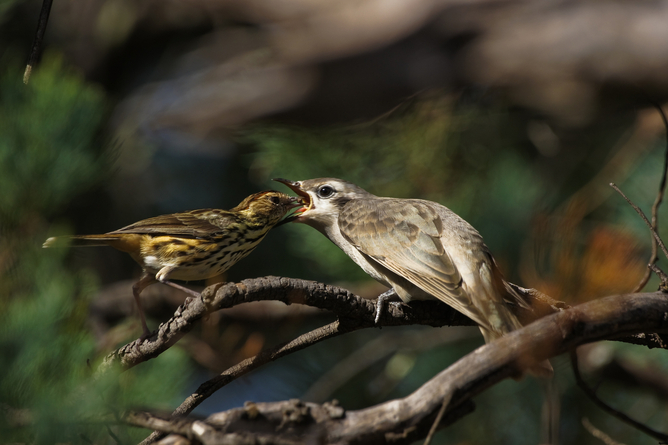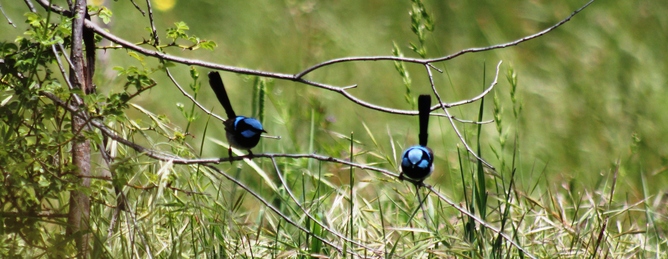
How Birds Cooperate to Defeat Cuckoos

This article was originally published at The Conversation. The publication contributed the article to LiveScience's Expert Voices: Op-Ed & Insights.
Why help another when you can help yourself? Cooperation is very common in nearly all life, from genes and cells to humans and other animals. However understanding why can be difficult: being selfish seems more rewarding. In a new study published in Science, we investigated whether the evolution of cooperative breeding in birds could be linked to defending their nests.
Cooperative breeding is when three or more individuals contribute to the care of young. While this happens in many animals, it is the social system of approximately 9% of birds, and is particularly prevalent in sub-Saharan Africa and Australasia.
However, understanding why evolution drove such behaviour remains controversial. Some studies have linked its occurrence with variable and unpredictable environmental conditions, while others have linked it to stable and predictable conditions.
We thought it might have something to do with defending their nests against brood parasitism, a behaviour where other birds to raise your babies. Brood parasitism is most easily recognisable among cuckoo birds, who never build their own nest or raise their own offspring. Instead they lay their eggs in the nests of birds from other species, and leave the substantial task of raising their chick to the unsuspecting host.
We suspected that if larger cooperative breeding groups are better able to defend their nests against brood parasitism, these breeding systems may be evolutionarily linked.
To investigate this question we first looked at the global distribution of cooperative breeding and brood parasitic bird species. If these breeding systems are linked, brood parasites and cooperative breeders should live in the same areas.
Get the world’s most fascinating discoveries delivered straight to your inbox.
We found that brood parasites and cooperative breeders are found in the same places around the world, with particularly high concentrations in sub-Saharan Africa and Australasia. So next we looked at whether hosts of brood parasites are more likely to be cooperative breeders. We conducted analyses focusing on Australia and South Africa as the species in these areas are particularly well understood. Again, we found that hosts of brood parasites were more likely to be cooperative breeders than non-host species in both these areas.
However, these analyses do not tell us whether cooperative breeders are being chosen by brood parasites, or if brood parasitism is driving species to become cooperative. To gain insight into this question, we conducted a detailed study of the superb fairy-wren (Malurus cyaneus). This bird cooperatively breeds, and is also a host of the Horsfield’s bronze-cuckoo (Chalcites basalis) in South-Eastern Australia.
First, we used data from Naomi Langmore, Robert Heinsohn and Rebecca Kilner’s long term study in Canberra to investigate whether cuckoos gained an advantage by parasitising larger groups. We found that they did; cuckoos raised by larger groups suffered lower predation and grew faster than those raised by smaller groups.
Next, we used long term data from the site in Canberra, as well as Raoul Mulder and Michelle Hall’s site in Lara (near Melbourne) to investigate whether larger groups of fairy-wrens were parasitised less than smaller groups. We found that larger groups were in fact parasitised less than smaller groups.
Despite benefits to cuckoos from exploiting larger groups, this exploitation was not occurring in nature. To investigate why this may be, we conducted a series of experiments. We presented fairy-wren groups with model cuckoos and a variety of other nest threats. We found that they have a cuckoo-specific alarm call that functions to rapidly attract other fairy-wrens to help attack the cuckoo. We also found that larger groups are more aggressive and more vigilant around their nest.
I have written previously about another study in which we found that this alarm call can be rapidly learned by watching the response of more knowledgeable fairy-wrens. Interestingly, the few other studies (such as those of colonial breeding southern red bishops, Euplectes orix and cooperative breeding carrion crows, Corvus corone corone) that have investigated this behaviour have also found larger groups of birds are better able to defend their nests.
Our study shows brood parasitism and cooperative breeding in birds are evolutionarily linked breeding systems, through a two-way process; brood parasitism is driving birds to become cooperative, and cooperation makes them better parents for brood parasite chicks. We suggest that if a cooperative breeding species becomes a host of a brood parasite, it should stay cooperative.
It is very interesting to think that interactions between two species may have the evolutionary potential to influence broad ecological patterns such as the global distribution of cooperation.
William Feeney receives funding from Australian Geographic and the Canberra Bird Conservation Fund.
Naomi Langmore does not work for, consult to, own shares in or receive funding from any company or organisation that would benefit from this article, and has no relevant affiliations.
This article was originally published at The Conversation. Read the original article. The views expressed are those of the author and do not necessarily reflect the views of the publisher. This version of the article was originally published on LiveScience.



